Silencer ventilation on tiptoe
What noise level is acceptable for ventilation? Which fans are quieter? Are there any ways to make the ventilation system as a whole less noisy? Let's try to answer these questions.

Norms
Let's start with the rules that must comply with the ventilation system.
| Type of room | Noise limits, dB |
| Hospital wards, sanatoriums, operating rooms | 20 |
| Living spaces | 25 |
| Hotels, offices, cabinets | 35 |
| School classes, auditoriums, libraries | 40 |
| Industrial premises | 50 |
| Cafe, restaurants, canteens | 55 |
| Shops, shopping centers, train stations, sports halls | 60 |
Sound sources
What could be the cause of noise spreading through the ventilation channels?
- Air swirls on the impeller blades. The greater the speed - the higher the noise level.
Note: the volume is influenced not only by the revolutions, but also by the shape of the blades. Their aerodynamic optimization can make the device less noisy with the same performance.
- Rotation of the bearing bush in its housing. First of all, this refers to rolling bearings: at low revs they are heard much better than plain bearings.

- Impeller imbalance vibration. It is transmitted to the fan casing, duct walls and (with sufficient power and weight) to the capital structures of the building.
- Finally, the source of aerodynamic noise at a certain flow rate can be the air itself moving through the duct.
Comprehensive measures
So, what can you do with your own hands for silent operation of the ventilation system?
Fans
Before installation, the fan is checked for balancing the impeller. The instructions are very simple: the impeller spins several times by hand. His repeated stop in the same position speaks of a clear imbalance; if the wheel stops each time in a new position - balancing is normal.
The lower the impeller speed at a fixed performance, the lower the noise level in general. The lack of revolutions is compensated by changing the angle of attack of the blades, their shape, area and, most importantly, the diameter of the impeller.

As mentioned above, a plain bearing is preferable. Here, however, there is one catch: with the same workmanship with the same rolling bearing, it has on average a smaller resource. That is why exhaust and duct fans from little-known manufacturers are a dubious purchase: their low price is compensated for by the additional costs of repairing or replacing in a year or two of operation.
Axial fans are generally quieter than radial fans. In the second case, the noise is created due to the minimum clearance between the impeller and the impeller.
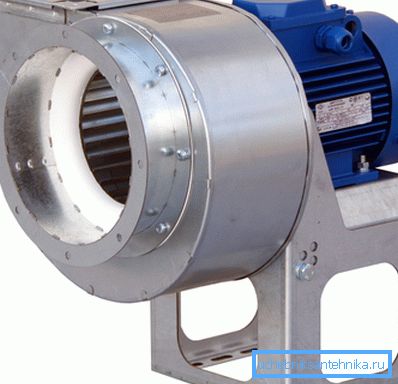
Several recommendations, the implementation of which will contribute to the quiet operation of the ventilation system, can be found in SNiP 3.05.01-85.
- Stationary fans are connected to the duct with a flexible insert (for example, from fiberglass). It prevents the transmission of vibrations.
- Radial fans of considerable power are mounted on anti-vibration bases.
- When coupling the transmission of torque from the electric motor to the fan, their shafts must be strictly coaxial; with a belt drive, the shafts should be parallel.
Ventilation channels
For them, the aforementioned SNiP also provides several requirements that, along with the safety of operation, are designed to ensure a low noise level.
The pitch of the mounting points of the ventilation channels is determined by their size, the method of connecting elements and orientation in space:
| Duct Type | Maximum step between fixation points, m |
| Flangeless with the largest size (diameter or larger side) up to 400 mm | four |
| Flangeless with the largest size over 400 mm | 3 |
| Flanged with the largest size up to 2000 mm | 6 |
| Vertical | four |
Important: at the points of fixation, the suspensions or supports partially absorb acoustic oscillations. The greater the gaps between them, the greater the maximum amplitude of oscillation (in other words, the louder the noise).
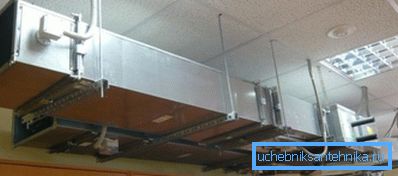
On flange connections, all bolts must be tightened. If the flange is held on, say, two bolts, then a metallic clank of the ducts is likely to be added to the noise of the air.
An important point: the air velocity in the ventilation channels of residential premises is limited to 4 m / s. At higher speeds, the stream begins to noisily make noise.
Finally, the thicker and more massive the duct wall, the worse it conducts sound.
For galvanized ducts and light plastic pipes, ventilation insulation can be any solution of any porous materials:
- Mineral wool, followed by strapping with a galvanized sheet.
- Foam or polyurethane shell.
- Polyethylene foam.
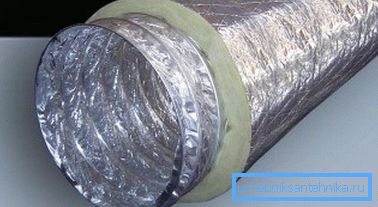
Silencers
The sound absorber (ventilation silencer) is an uncomplicated mechanical device designed to absorb acoustic vibrations. In the wide sale can be found two types of silencers.
Lamellar
Before us is a tin box, divided by a large number of parallel walls of air. A typical distance between them is 75-300 mm. Partitions are lined with sound-absorbing porous materials; to reduce aerodynamic drag, they are often supplied with fairings.
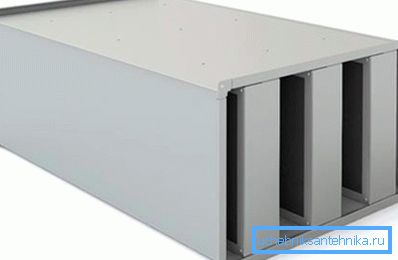
Tubular
The device is a sandwich of two pipes. Internal - perforated, with a diameter equal to the diameter of the attached duct. The outer casing is deaf; the space between the pipes is filled with sound-absorbing materials.
The price of such devices starts from about 1000 rubles. The reasonable minimum length of the pipe is 900-1000 millimeters.
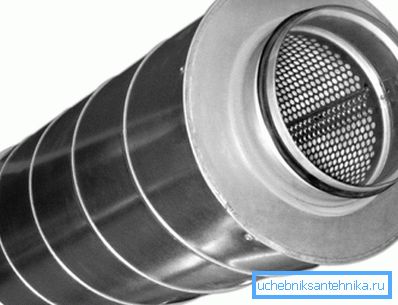
Conclusion
Hopefully, our recommendations will help the reader to make the ventilation system in their home noiseless. As usual, the video in this article will offer additional thematic information.
Successes!